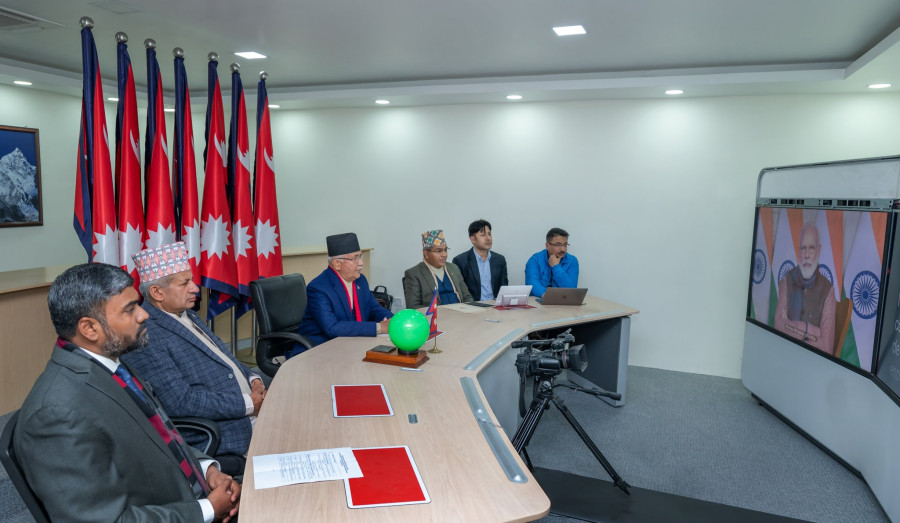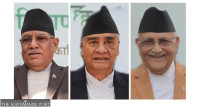National
As India, China talk to resolve border stand-off, analysts question when Delhi will speak to Nepal
The Modi government has said that dates for talks with Kathmandu will be worked out after Covid-19 crisis while recently holding dialogue with Beijing over its boundary dispute.
Anil Giri
India and China on Saturday held talks to resolve the month-long border stand-off in eastern Ladakh, with both sides agreeing to peacefully resolve the situation. Nepal, meanwhile, has been asking India to sit for talks since November, with New Delhi most recently saying that it’ll sit for talks once the Covid-19 pandemic is over.
It has been a month since India opened a road link via Lipulekh, prompting Nepal to formally lodge its objection and then release a new political map that includes Lipulekh, Kalapani and Limipiyadhura as parts of the Nepali territory.
Responding to Kathmandu’s initial objection, Delhi had acknowledged the need for dialogue but said that dates for talks would only be finalised after the Covid-19 emergency was dealt with.
But if Delhi can hold talks with Beijing during the pandemic, it can also do so with Kathmandu, say political party leaders and foreign policy experts.
“It looks like China is the priority for India at the moment due to the seriousness of the dispute but it also shows that talks can be held in any situation,” said Madhu Raman Acharya, a former ambassador and foreign secretary. “India needs to engage with Nepal.”
India and China have long-standing differences in eastern Ladakh over the Line of Actual Control. The current tensions arose after reports of skirmishes between soldiers from both sides, resulting in injury.
In the past too, soldiers from both the countries have crossed paths, only to retreat later.
This time around, New Delhi got alarmed after reports that Chinese soldiers had made multiple intrusions.
The tensions between Nepal and India over the Kalapani region, however, have not reached the level of scuffles between security forces, with both Kathmandu and Delhi now being in a state of “cartographic war”.
Analysts have been constant in suggesting that dialogue is imperative, as soon as possible.
A constitutional amendment bill registered by the KP Sharma Oli government is currently in Parliament, and a vote to fast-track its endorsement is likely on Tuesday or Wednesday. The bill will formalise the new Nepali map by revising it on the national emblem.
Ruling party leaders say that Prime Minister Oli is himself engaged in backchannel communications with various sources in New Delhi to kickstart talks at the Foreign Secretary level. There were even talks about a telephone conversation between Prime Minister Oli and his Indian counterpart Narendra Modi. The call never materialised.
Some members of the diplomatic circle in Kathmandu believe that the resolution of the India-China boundary dispute could help Nepal’s chances for talks, as the dispute between Nepal and India also includes China in some capacity.
“The present boundary dispute in Lipulekh warrants talks not only with India but also with China, and if Nepal wants to resolve the disputes with India–and later with China–this is the right time to engage,” a former Nepali diplomat told the Post.
Experts and analysts, back in 2017, had also said that Nepal should raise its boundary issues with India, including the row over Kalapani, Lipulekh and Limpiyadhura, when Delhi and Beijing were in a standoff over Doklam.
Earlier in 2015, Kathmandu had sent diplomatic notes to both Delhi and Beijing after they agreed to expand a trade route via Lipulekh without informing Nepal.
The Kalapani issue, however, was largely forgotten by the Nepali leadership in Kathmandu until November 2019 when India in its new political map placed the region within its borders.
Since November, Nepal has at least twice sought dates for talks at the Foreign Secretary level. Deferral of talks, however, was then attributed to a reshuffle in India’s Ministry of External Affairs.
Nepal has sent four diplomatic notes since.
The first note was dispatched on November 20, another on November 22 and one more on December 30. After opening up the new road in Lipulekh, Nepal sent another note to India on May 11.
India never responded to any of these notes.
But last month, for the first time, Delhi acknowledged talks as the only way to resolve the dispute after Nepal strongly protested the opening of the road via Lipulekh and handed Indian Ambassador Vinay Mohan Kwatra a diplomatic note.
“I fail to understand why India is setting conditions for talks with us,” said Bishnu Rijal, deputy chief of the ruling Nepal Communist Party’s international affairs department. “Now that India and China sat for talks at two levels despite the Covid-19 crisis, questions arise regarding their reluctance to hold a dialogue with Nepal.”
Rijal said that officials from both sides could at least talk via video conferencing to set the stage for further dialogue.
“Indian Prime Minister Narendra Modi held a virtual summit with the Australian prime minister last week. The Indian foreign minister has been holding virtual talks with several of his counterparts,” said Rijal. “So why isn't India ready to even hold a video conference with us?”
Some in Nepal believe that there is growing suspicion among Delhi officials that Nepal has been cosying up to China, which is why India is delaying talks with Nepal.
Indian Army Chief MM Naravane has been quite vocal in saying that Nepal was objecting to India’s opening of road via Lipulekh at China’s behest.
The Modi administration has neither owned up to Naravane’s statement nor rejected it. There has been no official statement from Kathmandu either regarding Naravane’s allegation.
According to a news report in the Indian Express on Sunday, Kathmandu has conveyed to Delhi that it is open to a virtual meeting between the foreign secretaries to resolve the border issue that is threatening relations.
“The Express has learnt that the Nepal government, via a note verbale (a diplomatic note), said that the foreign secretaries can meet in person or hold a virtual meeting to discuss the issue of Kalapani, Lipulekh and Limpiyadhura, that Indian territories it is claiming,” the news report said.
The report does not mention when Nepal communicated such a proposal.
A senior Foreign Ministry official, however, told the Post that no diplomatic note has been dispatched since May 11.
“It was through that note that Nepal sought a date for talks. It did not mention holding virtual talks,” said the official.
During a discussion at the International Relations and Human Rights Committee of the federal parliament on May 11, Foreign Minister Pradeep Gyawali had ruled out virtual talks, citing data security reasons.
While Gyawali did not elaborate on his concerns, Prime Minister Oli had participated in a virtual meeting of SAARC leaders initiated by Modi.
Ashok Mehta, a retired Indian Army general who closely follows Nepal affairs, said it would be wrong to compare the border disputes between Nepal and India with those between India and China.
“That said, Indian foreign secretary must ring up his Nepali counterpart,” Mehta said in an email interview.
Mehta called for immediate talks at the Foreign Secretary level so as to “defer constitutional amendment in Nepal” to update the map in the national emblem.
“A telephone conversation between the two prime ministers will be most useful,” said Mehta. “Once the Covid-19 crisis is over, face-to-face delegation level talks can be held between the two sides.”




 5.8°C Kathmandu
5.8°C Kathmandu










%20(1).jpg&w=300&height=200)




